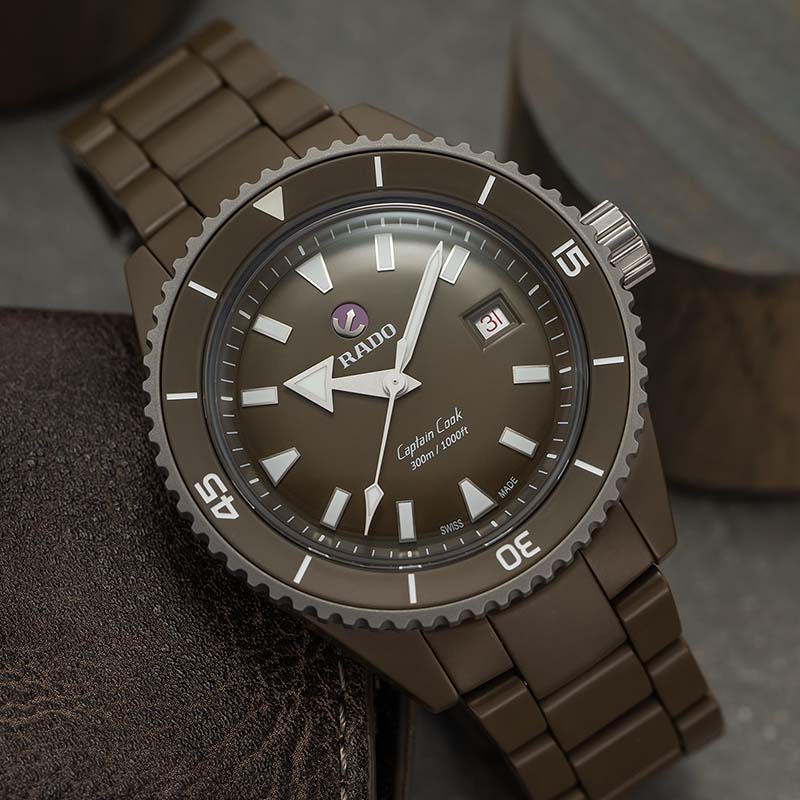Watch hands are more important to a timepiece's design than you might think. A watch can have the most beautiful dial in the world but it isn't really a watch unless it tells you the time. And while the wide world of watches does offer some intriguing exceptions to the classical analog style that's been established for centuries, the vast majority of timepieces still adheres to that formula: two main hands, one for the hour, one for the minute, sometimes joined by a third for the seconds, pointing to the time on a numbered ring. All watch hands do essentially the same jobs, so one might assume that little thought and creativity goes into designing and crafting such a utilitarian element of horology. One would be mistaken, however, since watchmakers over the years have created numerous hand types, each of which imparts its own distinctive character to a watch's overall aesthetic. Here is a rundown of a dozen of the most significant styles used on watches today, and a little about where each came from and how it got its name.
[toc-section heading="Breguet Hands"]

Designed by Abraham-Louis Breguet, founder of the eponymous luxury watch maison and inventor of numerous horological devices including the tourbillon, Breguet hands made their first appearance on a watch in 1783, Traditionally crafted in blued steel, they are recognizable for their slim shafts and “hollow moons” near the tips. An indicator of classically elegant design, and often paired with Roman numerals, or Arabic numerals in a vintage-style font, they can be found, of course, on just about every Breguet watch as well as other historically evocative timepieces from the likes of Patek Philippe, Frederique Constant, and Longines.
[toc-section heading="Dauphine Hands"]

Named either for “the dauphin,” the French term for the eldest son of the king, or a dolphin, the sea mammal whose silhouette they evoke, Dauphine hands emerged from the 1940s. (And it turns out that the two theories are not mutually exclusive: the French crown prince's coat-of-arms has dolphins on it, hence the historical shorthand.) Essentially tapering triangles or diamonds with sleek edges and facets, Dauphine hands generally denote a luxurious style of watch rather than a utilitarian or sporty style. Grand Seiko has become an acknowledged master of Dauphine hands, though the Japanese manufacture tends to refer to their version as “razor” hands, referring to their resemblance to razor blades.
[toc-section heading="Alpha Hands"]

Very similar to Dauphine hands in their triangular shape, Alpha hands (so named for their resemblance to the Greek letter “Alpha” and by extension the English letter “A”) are differentiated by the thin, tapering neck at their base, near the axis. Germany’s high-luxury paragon A. Lange & Söhne uses Alpha-shaped hands for several of its models, including the iconic Lange 1 and the Datoperpetual (pictured). Omega uses a distinctive set of Alpha hands on its Speedmaster Anniversary Series Chronograph, which replicates the first Omega worn in outer space. Parmigiani Fleurier has become known for, among other emblematic design details, its use of openworked Alpha hands on its timepieces.
[toc-section heading="Feuille Hands"]

Another style attributed to the French, feuille hands, alternately called leaf or leaf-shaped hands (feuille is French for “leaf”), are thin and tapered at both ends and wider in the middle, calling to mind small leaves or the petals of a flower. This organically inspired, curvilinear type of hand is often found on dress watch styles, like IWC’s Portugieser and many models from Patek Philippe. Complicated timepieces that strive for understated elegance in their appearance, like H. Moser & Cie.’s Perpetual Calendar above, are known to opt for leaf hands. The style is also sometimes used for the smaller hands on subdials for an aesthetic contrast with another set of main hands.
[toc-section heading="Baton Hands"]

A straightforward, no-frills type of hand with straight edges, a uniform width rather than a tapered design, and either flat or bluntly rounded ends, the baton style is generally (but not exclusively) applied to more utilitarian styles of watches. They’re most often paired up with similarly baton-shaped hour markers (as on the Bell & Ross BR 05 featured here) for a smoothly integrated, legible aesthetic on a dial. Many watchmakers have developed their own signature takes on the baton-style handset, including Audemars Piguet for its original Royal Oak and Patek Philippe for the Nautilus.
[toc-section heading="Sword Hands"]

One of the most popular and versatile styles, sword hands are recognisable for their straight sides and sharp triangular tips, reminiscent of a sword blade. Sword hands, many of which also have a central ridge that emphasises the motif, can be dressed up or down; they can be long and slender or short and wide, and they can be partly or fully skeletonised. No one’s quite sure when the first sword hands appeared on a watch, though they’ve been around since the early 20th Century; the iconic Cartier Tank, introduced in 1918, may have been the most influential watch in popularizing the style, which today is just as prevalent on decidedly masculine, tool-oriented timepieces like the Panerai Submersible (pictured) as on more elegant and classical models like the Tank and its many descendants.
[toc-section heading="Cathedral Hands"]

Imagine the pointed arches of a Gothic cathedral and you’ll have an idea where these ornate hands got their name. This handset usually matches up a bulbous, cupola-like hour hand (it might remind some of a bishop piece in a chess set) with a longer, skyscraper-like, thin-tipped minute hand that widens from its base to its pointer. Found on watches like those in the Oris Big Crown series and Seiko’s Prospex “Alpinist” models (pictured), they are particularly useful at differentiating the hour from the minutes at a glance and can be incorporated successfully on both dressy and sporty types of dials despite their historical connotations.
[toc-section heading="Syringe Hands"]

Anyone who’s ever gotten a flu shot can probably guess where these baton-style hands with long, extended pointers get their name. Generally straight-sided, somewhat wide, and tapering to needles on both the hour and minute hand, syringe hands are a style long associated with historical watches, used as early as the 1930s by Patek Philippe (although it’s unclear whether Patek was their originator). Today, these medical-instrument-style hands can also be found on military-style watches like the Hamilton Khaki Field (above) — possibly because despite their somewhat ornate look, they combine two functional details for use by soldiers: they’re wide enough to be legible (especially if luminous-treated) and yet also pinpoint-accurate enough at the tips to time operations with precision.
[toc-section heading="Mercedes Hands"]

The shape of the hour hand on this set, reminiscent of a badge very familiar to automobile enthusiasts, gives this style its name. Most widely known for its use in iconic Rolex sport-luxury watches like the Explorer, Submariner, and GMT-Master, the Mercedes hour hand has no official connection to the Mercedes logo (whose three-pointed star motif represents the three types of transportation, land, sea, and air) and it is not exclusive to Rolex. Theories as to why Rolex started using it in the 1950s are several: it’s a subtle tribute to British swimmer Mercedes Gleitze, who appeared in early ads for the Rolex Oyster; it’s founder Hans Wilsdorf’s tribute to his homeland of Germany (the birthplace of Mercedes cars); it’s just an evolution of cathedral hands for the sports-watch era, and the logo resemblance is a coincidence. Or none of the above.
[toc-section heading="Snowflake Hands"]

The origin of the snowflake handset, used more or less exclusively by Tudor on its vast collection of Black Bay and Pelagos dive watches, is one of the few that can be traced to a specific watch model and year. It made its debut on the Tudor Submariner Refs. 7016 and 7021, released in 1969, the primary template for today’s Black Bay models. Sources say that the vintage Submariner’s intended audience, French military divers, influenced Tudor’s decision to adopt the quirky, angular shape of the hour hand, which somewhat resembled a segment of a snowflake (or more accurately, a cartoon representation of one). Such a hand, paired with a more traditional sword-shaped minute hand and a ring of blocky hour markers, offered greater legibility and differentiation between hands as well as more surface area for lume. These days, if you’re seeing this type of handset, you can be almost certain you’re looking at a Tudor.
[toc-section heading="Arrow Hands"]

While Mercedes hands scream Rolex (or Rolex homage) and Snowflake hands are an instant giveaway for Tudor, arrow-shaped hands — most often referred to as “Broad Arrow” — are predominantly associated with Omega, specifically vintage Omega. The trio of sport models that Omega unveiled in 1957 — the Speedmaster, Seamaster, and Railmaster — ushered in the style, which combines a wide arrow-pointed hour hand on a triangular shaft for the hours and a longer, sharp-pointed triangular hand for the minutes. Omega retired the “broad arrow” design shortly thereafter, though the resurgence of vintage watch styles has brought it back to some extent, notably on retro-homage models like the Speedmaster ‘57 (pictured) and Seamaster 300 Heritage pieces. The Seamaster Planet Ocean collection features a variation of the original handset, with arrow tips for both the hour and minute hands. Omega doesn't have sole possession of these hands, though: they're also a fixture on Rado's Captain Cook dials.
[toc-section heading="Lollipop Hands"]

While just about every other hand style on this list is employed for hour and minute hands, the stars of a watch dial’s show, the lollipop hand is included here to represent the crucial but often underappreciated (in terms of hand design) supporting player, the seconds hand. The source of its nickname is fairly obvious — a prominent, round bulge at or near the tip of a thin stick, evoking a confectionary treat from childhood — and its form is definitely functional. Often found on dive watches, with the “lollipop” bubble treated with luminous paint, this type of seconds hand makes it easy to see at a glance if your watch is functioning, even in pitch darkness or murky underwater depths.
[toc-section heading="Teardrop Hands"]

Francois-Paul Journe has become renowned for doing things his own way, from both a technical and an aesthetic standpoint, and this iconoclastic approach extends to the hands on his watches. Beginning with the groundbreaking Tourbillon Souverain in 1999, which put his eponymous brand on the map for in-the-know enthusiasts, Journe has used very distinctive teardrop-shaped hands on his dials, often crafted from blued steel. Odd yet undeniably elegant, and today found almost exclusively on F.P. Journe dials, these hands are always rounded at their wider end, with a taper that can be short, for smaller indicators like subdials; or long, as for a central minutes hand.
[toc-section heading="Foundation Hands"]

British watchmaker Peter Speake’s first independently produced timepiece was called the Foundation — appropriately, as it was the cornerstone that the Speake-Marin brand was built upon. The unusual set of hands that he developed for (and named for) that piece is still a fixture on Speake-Marin watch dials today. Foundation handset is characterised by a short, spade-shaped hour hand and a slimmer, more extended minute hand that somewhat resembles a spear. Foundation hands are a defining detail of Speake-Marin watches, along with the emblematic watchmakers’ “topping tool” imagery in the logo and tourbillon bridge.



















































1 Comment
1